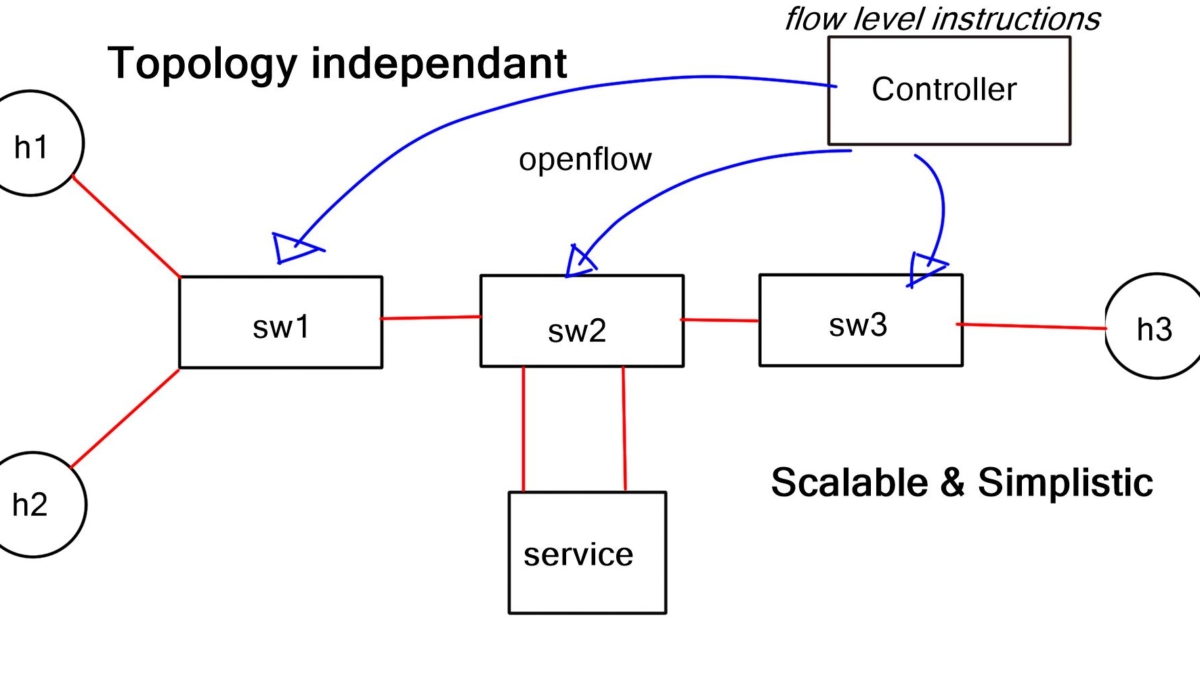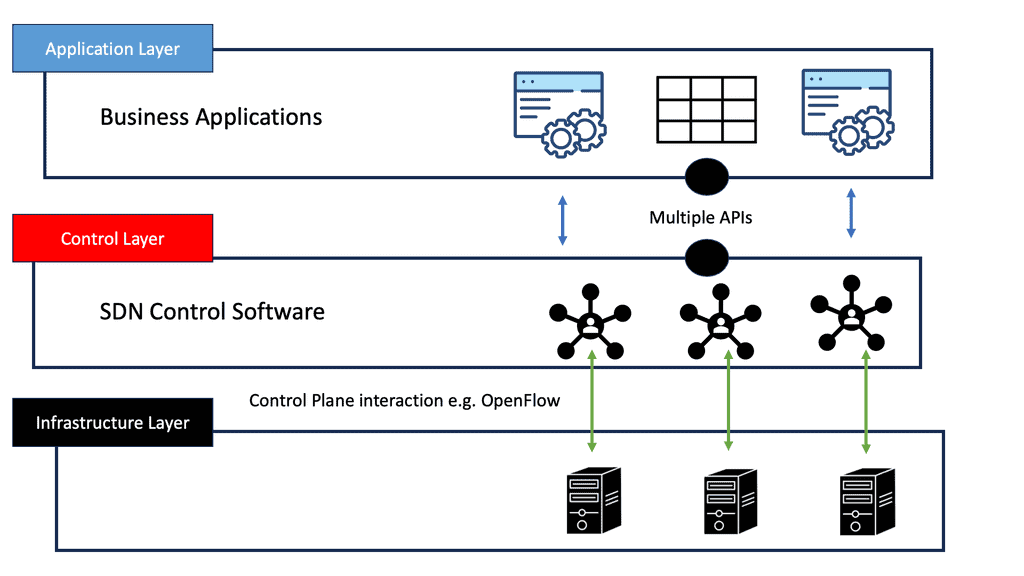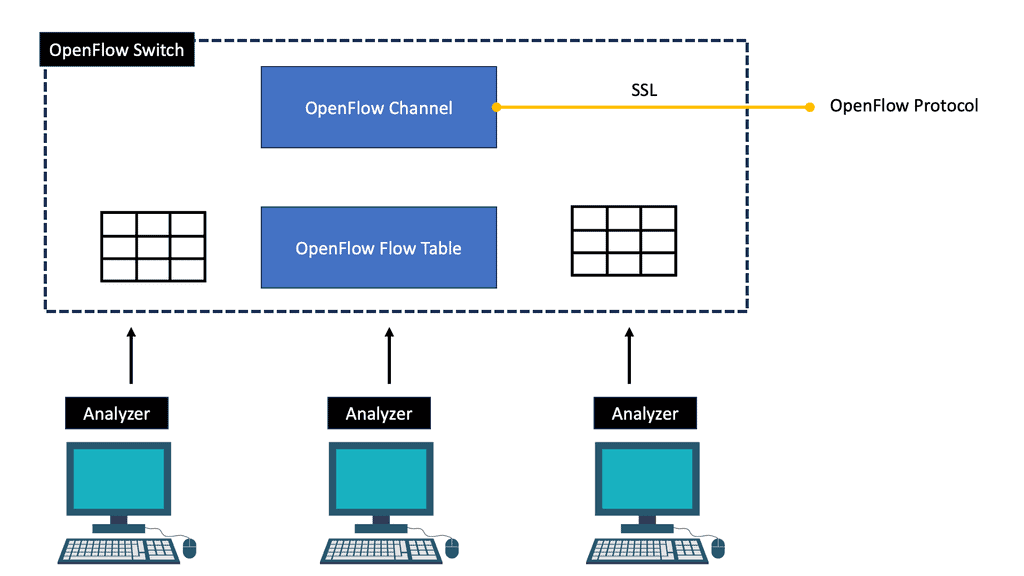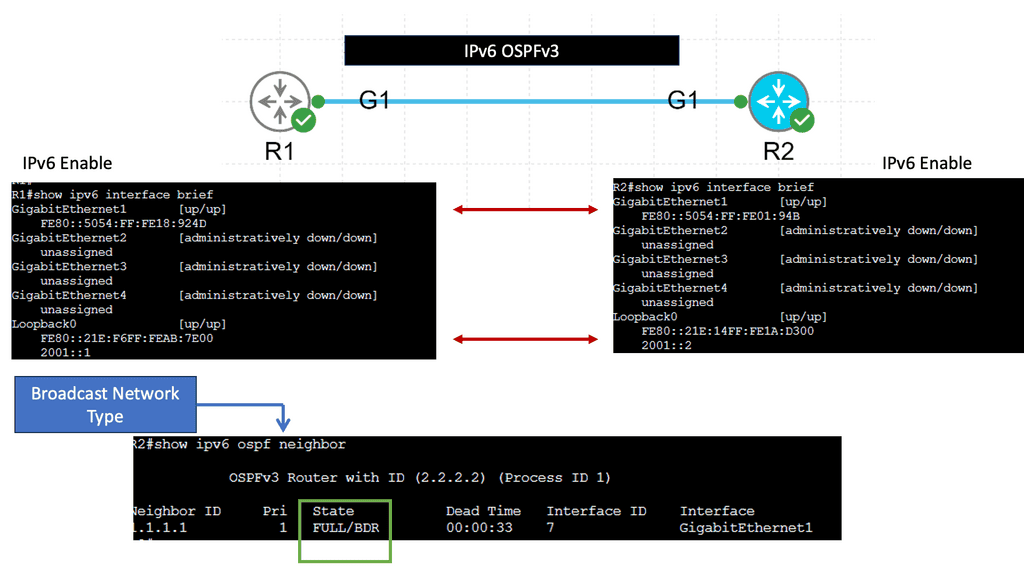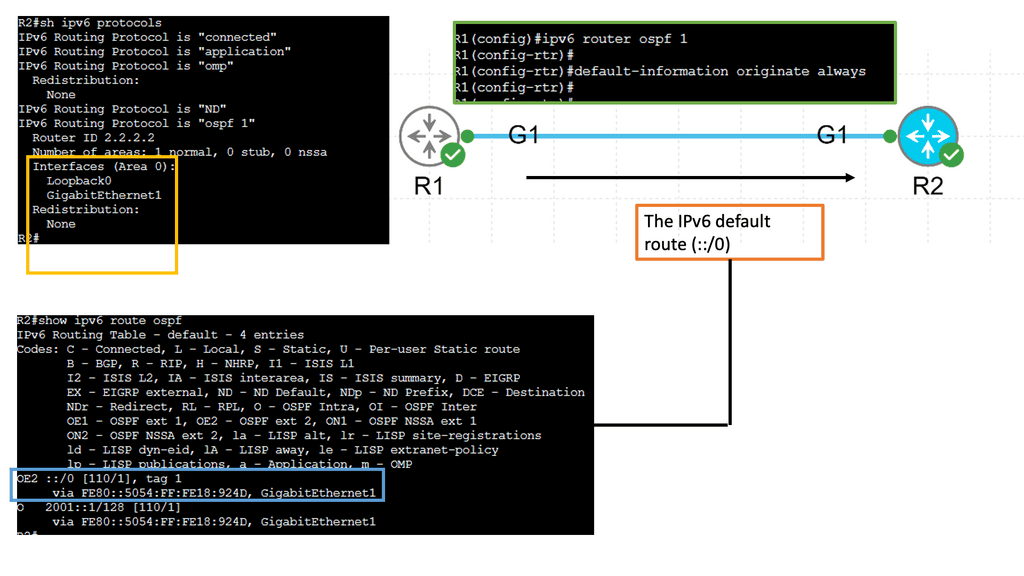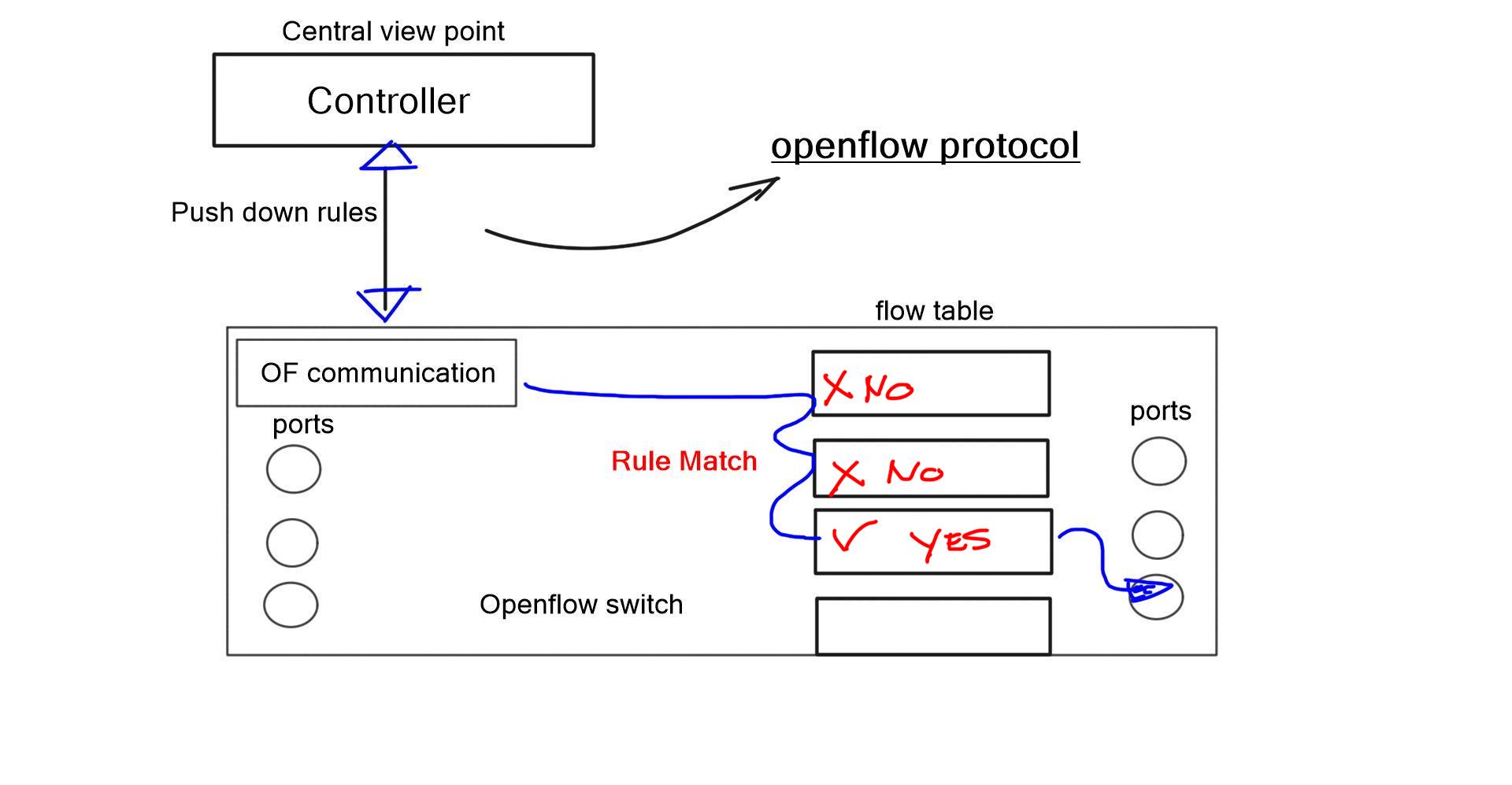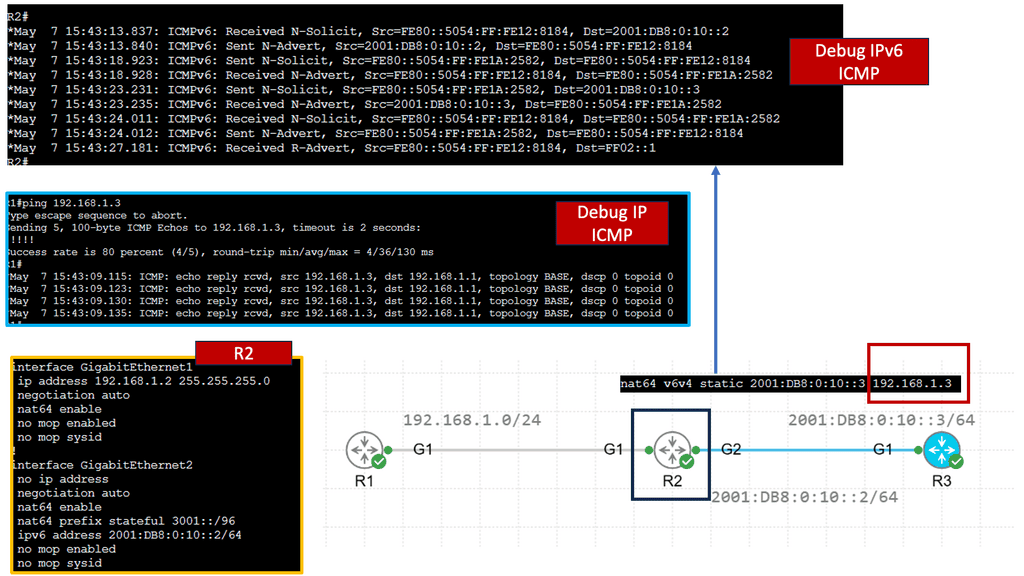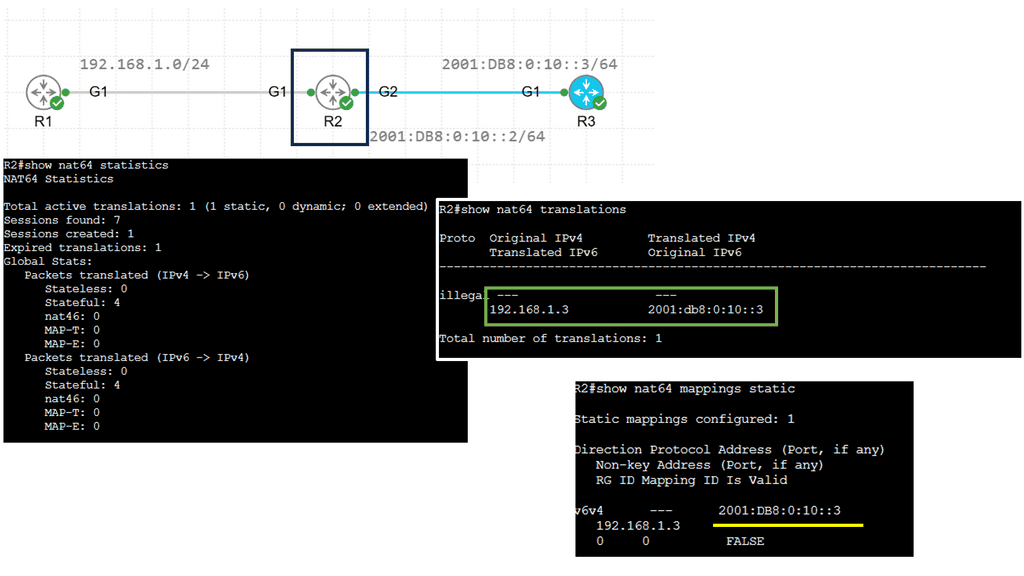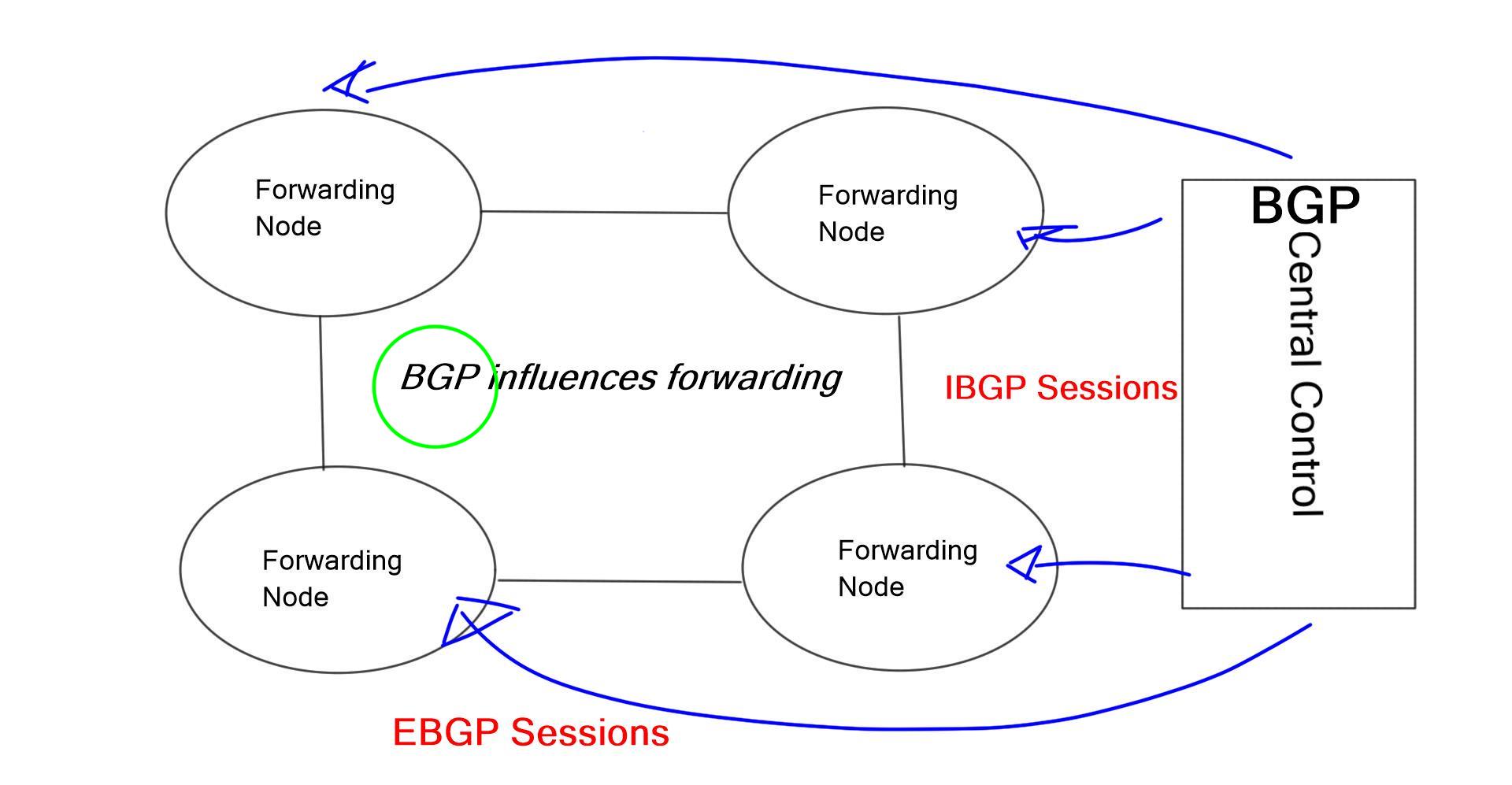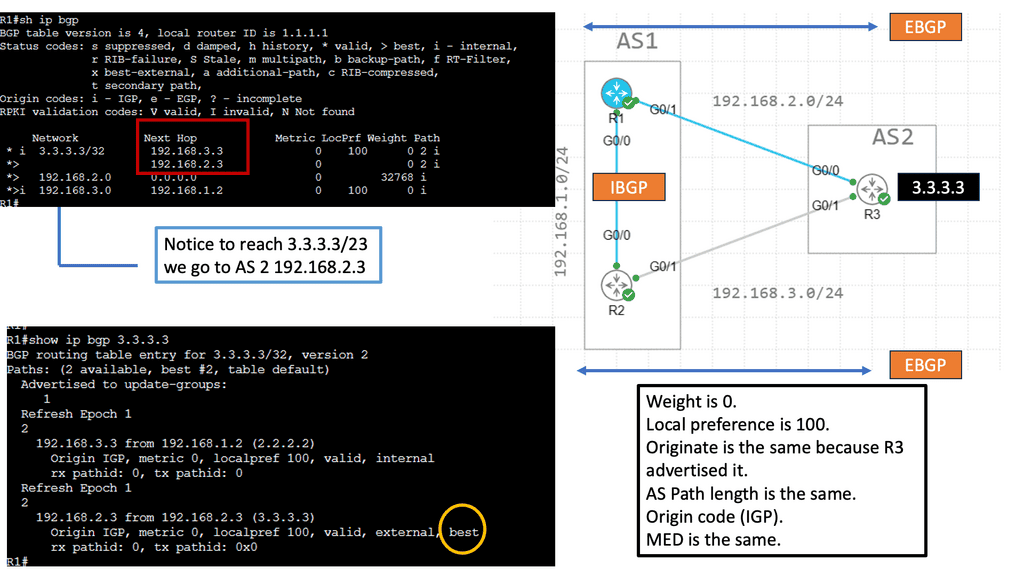OpenFlow and SDN Adoption
In the ever-evolving world of networking, new technologies and approaches continue to reshape the landscape. One such technology that has gained significant attention is OpenFlow, which forms the backbone of Software-Defined Networking (SDN). In this blog post, we will delve into the concept of OpenFlow and explore its growing adoption in the networking industry.
OpenFlow can be best described as a protocol that enables the separation of the control plane and the data plane in a network. Traditionally, network devices handled both the control and data forwarding aspects, leading to limited flexibility and scalability. With OpenFlow, the control plane is centralized in a controller, allowing for dynamic network management and programmability.
Benefits of OpenFlow: The adoption of OpenFlow brings forth a multitude of benefits. Firstly, it offers network administrators unprecedented control and visibility into the network, empowering them to efficiently manage traffic flows and implement changes on the fly. Additionally, OpenFlow promotes network programmability, enabling the development of innovative applications and services that can harness the full potential of the network infrastructure.
OpenFlow in Action: Numerous organizations and industries have recognized the potential of OpenFlow and have embraced it in their networks. For instance, data centers have leveraged OpenFlow to create virtual networks with enhanced security and improved resource allocation. Internet Service Providers (ISPs) have also adopted OpenFlow to optimize traffic routing and enhance network performance.
Challenges and Considerations: While OpenFlow holds great promise, it is not without its challenges. One of the primary concerns is ensuring interoperability across different vendors and devices, as OpenFlow relies on a standard set of protocols and features. Additionally, network security and policy enforcement must be carefully addressed to prevent unauthorized access and protect sensitive data.
OpenFlow and SDN adoption are revolutionizing the networking industry, offering unprecedented control, programmability, and scalability. As organizations continue to recognize the benefits of OpenFlow, we can expect to see further advancements and innovations in the realm of network management and infrastructure.
Matt Conran
Highlights: OpenFlow and SDN Adoption
Understanding OpenFlow
OpenFlow is a communication protocol that enables the separation of the control plane and the data plane in network switches. By doing so, it allows for centralized control and programmability of network devices. This revolutionary approach replaces traditional, fixed-function network devices with programmable switches, enabling more flexibility and agility in network management.
SDN provides network administrators with a holistic view of the network, allowing them to monitor and manage network traffic with granular control. This increased visibility enables better troubleshooting, efficient resource allocation, and improved security measures.
**Simplified Network Management**
With SDN, network configurations can be abstracted and managed through software, eliminating the need for manual, device-by-device configuration changes. This simplification streamlines network management, reduces human errors, and accelerates network provisioning and deployment.
The programmability of SDN allows for dynamic network provisioning and scaling, making it easier to adapt to changing network demands. Whether it’s scaling up to accommodate increased traffic or reconfiguring network paths, SDN offers unparalleled flexibility, enabling networks to evolve and grow seamlessly.
**SDN & Virtualization**
SDN opens doors to network virtualization, where multiple virtual networks can coexist on a shared physical network infrastructure. This concept enables efficient resource utilization, isolation of traffic, and improved network efficiency.
By decoupling the control plane from the data plane, SDN fosters an environment for experimentation and innovation. Developers can create and deploy custom network applications, allowing for rapid prototyping and testing of new networking concepts without disrupting the underlying infrastructure.
**Basics of Network Virtualization**
Network virtualization involves creating a virtual network that operates independently of the underlying physical hardware. This is achieved through software-defined networking (SDN) and network functions virtualization (NFV). SDN separates the network’s control plane from the data plane, allowing for centralized management and control of network traffic. NFV, on the other hand, replaces traditional network hardware functions with software-based solutions, enabling greater flexibility and scalability.
Use Cases and Real-World Applications
A: -) OpenFlow and SDN have been found to be extensively used in various domains and industries. From data centers and cloud computing environments to enterprise networks and even telecommunications, the versatility of OpenFlow and SDN is undeniable.
B: -) They enable dynamic traffic engineering, efficient load balancing, and improved network security. Furthermore, SDN has paved the way for network function virtualization (NFV), allowing the deployment of network services as software applications rather than dedicated hardware.
Impact on the Networking Landscape
– At its core, OpenFlow is a communications protocol that enables the separation of the control plane and the data plane in networking devices. It allows for the programmability and centralized control of network switches and routers. With OpenFlow, network administrators can dynamically manage traffic, define routing paths, and apply policies, all through a centralized controller.
– SDN takes the concept of OpenFlow further by providing a framework for network management and configuration. It abstracts the underlying network infrastructure and allows for programmability and automation through a software-based controller. SDN architectures offer flexibility, scalability, and agility, making adapting to evolving network demands easier.
– The combination of OpenFlow and SDN brings numerous benefits to network operators, administrators, and end-users. Firstly, it simplifies network management by providing a centralized view and control of the entire network.
– This simplification leads to enhanced network visibility, easier troubleshooting, and faster deployment of new services. Additionally, OpenFlow and SDN enable network virtualization, allowing for the creation of logical networks decoupled from the physical infrastructure.
The SDN Layers
The Application Layer:
As its name suggests, this layer includes network applications. Examples of these applications include communication applications, such as VoIP prioritization, and security applications, such as firewalls. Also included in this layer are utilities and network services.
Switches and routers traditionally handled these applications. SDN simplifies their management by offloading them. In addition, companies can save a lot of money by stripping down the hardware.
The Control Layer:
Switches and routers are now controlled by a centralized control plane, which allows the network to be programmed. As an open-source network protocol, OpenFlow has become the industry standard despite Cisco’s OpenFlow variant.
The Infrastructure Layer:
This layer includes data, switches, and routers. Traffic is moved according to flow tables. SDN leaves this layer essentially unchanged since routers and switches still move packets. The main difference is the centralization of traffic flow rules. However, the intelligence of vendor devices is not stripped away.
The API provides centralized control of SDN for large network providers to protect their intellectual property. However, the cost of generic packet-forwarding devices is much lower than traditional networking equipment.
A Programmable Network
Developers have made it possible for network administrators to create “slices” that allow generic networking hardware to support multiple configurations by adding a virtualization layer between the control system and the hardware layer. It resembles how a hypervisor can run a virtual machine (VM) on a single server. Using SDN, an administrator can create different rules and applications for various groups of users.
Because most applications are not installed on the devices, SDN enables the network to appear as one big switch/router. There could be three devices on the network or 30,000. They are all the same as centralized applications. (Some applications are just nodes on the network.) Therefore, upgrades, changes, additions, and configurations are much more accessible.
The role of OpenFlow
Firstly, the basis of the SDN adoption report is the OpenFlow protocol, an existing technology derived from academic labs. Its origins can be traced back to 2006 when Martin Casado, part of the “Clean Slate” program, developed Ethane. They were trying to figure out ways to manage the network states via a centrally managed global policy.
The idea that networks are dynamic and non-symmetrical poses challenges in keeping track of their state to enforce programmability. The program has stopped but produced several follow-up programs, including OpenFlow and SDN.
SDN OpenFlow is not revolutionary new. Similar ideas have been available, and previous projects have tried to solve the same problems OpenFlow is trying to solve today. Besides the central viewpoint use case, whatever you can do with OpenFlow today is possible with Policy-Based Routing (PBR) and ACL. The problem is that these tools are clumsy and do not scale well.
You may find the following useful for pre-information:
OpenFlow and SDN Adoption
What is OpenFlow?
OpenFlow is an open standard that enables the separation of the control plane and the data plane in network devices. It allows network administrators to centrally control and manage the behavior of network switches and routers, resulting in increased network programmability, flexibility, and scalability. OpenFlow provides a standardized protocol that facilitates communication between the control and data planes, enabling the network to be programmed and controlled through software.
Understanding SDN Adoption:
SDN is a paradigm shift in network architecture that leverages OpenFlow and other technologies to virtualize and abstract network resources. With SDN, the control plane is decoupled from the underlying physical infrastructure, allowing network administrators to configure and manage networks dynamically through a centralized controller. This centralized control simplifies network operations, enhances automation, and creates innovative network services.
The use of APIs:
Besides the network abstraction, the SDN architecture will deliver a set of APIs that streamline the implementation of standard network services. These network services include routing, security, access control, and traffic engineering. Consequently, we can achieve exceptional programmability, automation, and network control, enabling us to build highly scalable and flexible networks that readily adapt to changing business needs. Then, we have OpenFlow and the SDN story. OpenFlow is the first standard interface explicitly designed for SDN, providing high-performance and granular traffic control across multiple networking devices.
**Benefits of OpenFlow and SDN Adoption**
The adoption of OpenFlow and SDN comes with numerous benefits for organizations of all sizes:
1. Enhanced Network Programmability: OpenFlow and SDN enable network administrators to program and control networks through software, making implementing new network services and policies easier.
2. Increased Flexibility and Scalability: SDN allows for dynamic network reconfiguration and resource allocation, ensuring networks can adapt to changing requirements and scale efficiently.
3. Centralized Network Management: With SDN, network administrators can manage and configure multiple network devices from a centralized controller, simplifying network operations and reducing the complexity of managing traditional networks.
4. Improved Network Security: SDN facilitates the implementation of granular security policies, enabling network administrators to quickly detect and respond to security threats, enhancing overall network security.
**Challenges and Considerations**
While OpenFlow and SDN offer significant advantages, their adoption comes with a few challenges that organizations need to address:
1. Compatibility: Not all network devices and vendors fully support OpenFlow and SDN, requiring organizations to consider device compatibility carefully before implementation.
2. Skillset and Training: SDN introduces new concepts and requires network administrators to acquire skills and knowledge to deploy and manage SDN-based networks effectively.
3. Transition from Legacy Infrastructure: Migrating from traditional networking solutions to SDN-based architectures requires careful planning and a phased approach to minimize disruptions and ensure a smooth transition.
Starting Points for SDN Adoption
SDN Architectures and OpenFlow
SDN architectures and OpenFlow offer several advantages. You can influence traffic forwarding behavior at a more granular flow level. A holistic view instead of a partial view of distributed devices simplifies the network. Traffic engineering with SDN becomes easier to implement when you have a centralized view; this is how Google implemented SDN. Google has two network backbones: an Internet-facing backbone and a data center backbone.
They noticed that the cost/bit was not decreasing as the network grew. It was doing the opposite. Their solution was to implement a centralized controller and manage the WAN as a fabric, not as a collection of individual nodes.
SDN adoption report: Virtual switching fabric
SDN architectures allow networks to move from loosely coupled systems to a virtual switching fabric. One extensive flat virtualized network that appears and can be managed as a single switch has many operational advantages. The switch fabric consists of multiple physical nodes but behaves like one big switch. For example, a port on any underlying switch fabric nodes or virtual switch appears as a port to the single switching fabric.
The entire data plane becomes an abstraction. By employing this architecture, we manage the data plane as a whole entity instead of a set of loosely coupled connected devices. If we study existing networks, the control and data planes are distributed to the same locations. No central point controls individual nodes, resulting in complex cross-network interactions.
Open Shortest Path First (OSPF)
Open Shortest Path First (OSPF) calculates the shortest path tree from each node to every other node. Each OSPF neighbor must establish an adjacency and build and synchronize the link-state databases (LSB). The complexity can be reduced by designing OSPF areas with ABRs but by sacrificing some precision of route information. Imagine that every node reports and synchronizes its LSB to a central controller with an OSPF SDN application instead of individual nodes.
The controller can perform the Shortest Path First (SPF) calculation and directly update each node’s forwarding information base (FIB). The network now becomes programmable. While it does bring advantages, the laws of physics have not changed.
OpenFlow does not decrease latency or let you push more bits through a link. It does, however, let you better manage and control your network. It removes the box-by-box mentality and introduces automation and programmability.
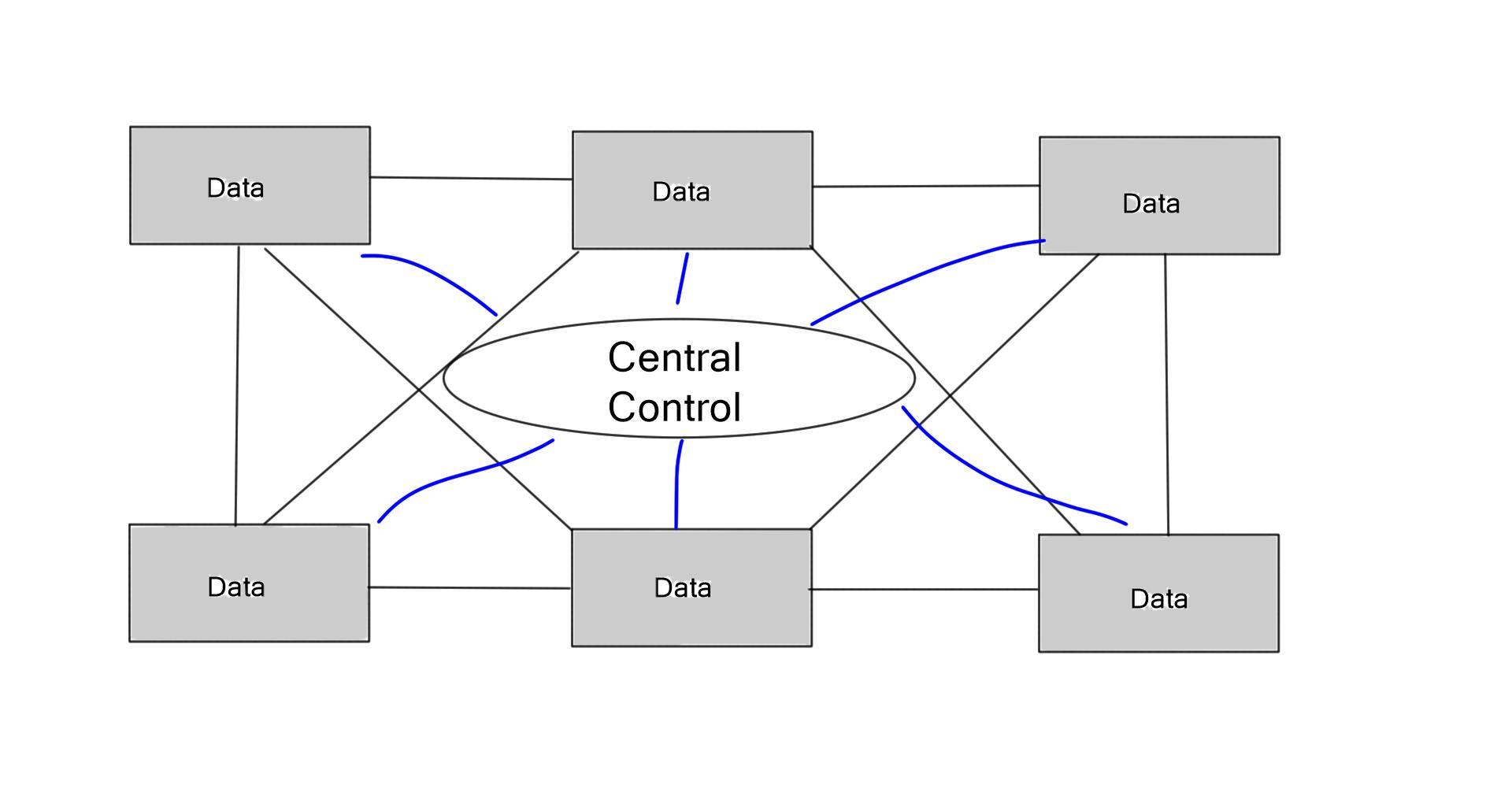 Example Routing Technology with OSPF
Example Routing Technology with OSPF
#### Introduction to OSPFv3
In the realm of networking, efficient and reliable routing protocols are crucial for ensuring seamless data transmission. One such protocol that has gained prominence is OSPFv3 (Open Shortest Path First version 3). This blog post will delve into the intricacies of OSPFv3, exploring its features, benefits, and the role it plays in modern networks.
#### Understanding OSPFv3 Basics
OSPFv3 is an evolution of the OSPF protocol, specifically designed to support IPv6. While it retains the core functionalities of its predecessor, OSPFv2, OSPFv3 brings enhancements that make it more suitable for IPv6-based networks. Unlike OSPFv2, which operates at the network layer, OSPFv3 is designed to work with both IPv4 and IPv6, offering greater flexibility and future-proofing networks as organizations transition to IPv6.
#### Key Features of OSPFv3
One of the standout features of OSPFv3 is its capability to support multiple instances per link. This means that different OSPFv3 processes can operate over the same network link, providing advanced network segmentation and improved routing efficiency. Additionally, OSPFv3 introduces a simplified header format, reducing overhead and enhancing performance. The protocol also supports address families, allowing for more granular control over routing decisions.
#### OSPFv3 vs. OSPFv2: What’s the Difference?
While OSPFv2 and OSPFv3 share a common heritage, there are notable differences between them. OSPFv3’s support for IPv6 is the most significant distinction, but it also includes changes in LSA (Link State Advertisement) types and packet structures. Furthermore, OSPFv3 operates with a more modular approach, separating topology information from routing information, thereby improving scalability and efficiency in complex network environments.
Do you think OpenFlow will be derailed?
SDN OpenFlow has come up against some market adoption barriers, such as silicon challenges and numerous vendor-specific extensions. In addition, the lack of conformance tests has led to some inconsistencies. It depends on how you define it. To explain it, you need to know what it is not. It is not a controller or a forwarding switch but a communication between the two.
It has a distinct place in the SDN architecture and does not run anywhere except between the control (controller) and the data plane, such as the OVS bridge acting as the switch infrastructure. SDN OpenFlow is also not alone in this space; other technologies provide control and data plane communications, such as BGP, Open vSwitch Database Management Protocol (OVSDB), NETCONF, and Extensible Message and Presence Protocol (XMPP).
Juniper’s OpenContrail uses XMPP.
It is evolving, and emerging technologies are sometimes slow to adopt. For example, in the early days of Novell networks, there were 4-frame types. Likewise, OpenFlow is changing and adapting as time progresses. For example, the original version of OpenFlow did not have multiple flow tables; now, versions 1.3 and 1.4 have multiple tables with various actions and many additional features.
**Will it be used for program forwarding paths instead of BGP?**
Probably not, but it will augment BGP and other traditional technologies. It is not strictly a YES or NO answer as the SDN adoption falls into two buckets: one with OpenFlow and one without. Take the IPv6 adaptations as the IPv4 “replacement.” There was a “D” day of IPv4 address exhaustion, but IPv4 is still widely used. New “transition” mechanisms such as 6to4 and NAT64 are still widely deployed. It is the same with SDN and OpenFlow.
Example IPv6 Technology: NAT64
**How NAT64 Works**
NAT64, short for Network Address Translation from IPv6 to IPv4, acts as a translator between IPv6 and IPv4. It allows IPv6 clients to access IPv4 services by translating IPv6 addresses into IPv4 addresses and vice versa. This is achieved through a NAT64 gateway, which facilitates the exchange of data between the two different protocols. The gateway assigns an IPv6 prefix for the IPv4 address pool, enabling seamless communication across the network. Understanding this process is vital for network administrators tasked with managing hybrid networks during the transition phase.
**Benefits of Implementing NAT64**
Implementing NAT64 offers numerous benefits for organizations and network administrators. Firstly, it aids in the gradual transition to IPv6 by allowing IPv6-only devices to access IPv4 content. This is particularly beneficial for mobile networks and new internet service providers aiming to future-proof their infrastructure. Additionally, NAT64 reduces the need for dual-stack configurations, which can be complex and resource-intensive. By simplifying network configurations, NAT64 helps cut operational costs and streamline network management.
There will be ways to make traditional networks communicate with SDN and OpenFlow. BGP was invented as an EBGP, but people use EBGP Internal in their network. BGP is also used as an SDN control plane. It will be the case that you have controllers that provide automation and a holistic view but can speak BGP or OSPF to program the forwarding devices. SDN migrations will come incrementally, similar to what we see with IPv4 and IPv6
The lack of clarity in the controller space has limited OpenFlow’s progress. However, the controller market is consolidating now, which gives users a clear path forward. This emergence is a good thing and will move OpenFlow forward. Maintaining SDN applications on different controllers is a dead end, but now that OpenDaylight is emerging, we have controller unity.
A market with numerous open-source controllers would make SDN application development difficult. There will always be business drivers for proprietary controllers serving a particular niche and corner case problems the open community did not invest in. Even today, specialized UNIX platforms exist when you look at open Linux. Similarly, this adoption of technology will be evident for OpenFlow controllers.
Example BGP Technology: EBGP and IBGP
### Understanding BGP: The Basics
Before diving into the preferences, it’s crucial to understand what BGP is. Border Gateway Protocol (BGP) is a standardized exterior gateway protocol designed to exchange routing and reachability information among autonomous systems (AS) on the internet. It is key to ensuring data finds the most efficient path across the complex web of networks.
– **eBGP vs. iBGP:** eBGP is used for communication between different autonomous systems, while iBGP is used within the same autonomous system. This distinction is fundamental in understanding their roles and why eBGP is often preferred.
### The Preference for eBGP: Key Reasons
1. **Policy Control and Flexibility:** eBGP allows for more granular policy control, enabling network administrators to implement routing policies that align with business objectives. This flexibility is less pronounced in iBGP, which is typically used to propagate routes within an AS.
2. **Route Propagation and Stability:** eBGP sessions are generally between routers in different administrative domains, which inherently adds a layer of stability and security in route propagation. eBGP routes are often considered more reliable due to the distinct boundaries they operate across.
3. **Loop Prevention Mechanics:** eBGP inherently prevents routing loops by default, due to its AS-path attribute which records the path that routing information has traversed. iBGP requires additional mechanisms, such as route reflectors or confederations, to handle loop prevention efficiently.
### Practical Implications for Network Administrators
Understanding the preference for eBGP over iBGP can significantly impact how network administrators design and manage networks. For instance, leveraging eBGP for inter-AS communication can lead to more robust and secure network architectures. Additionally, the ability to set preferences for route selection can optimize traffic flow and enhance network performance.
The Future of OpenFlow and SDN:
The adoption of OpenFlow and SDN has gained significant momentum in recent years, and the future looks promising for these technologies. With the increasing demand for flexible, scalable, and programmable networks, OpenFlow and SDN are vital in deploying 5G networks, Internet of Things (IoT) applications, and network virtualization.
OpenFlow and SDN adoption revolutionizes network infrastructure, offering increased programmability, flexibility, and centralized management. While challenges exist, the benefits of OpenFlow and SDN far outweigh the drawbacks.
As organizations continue to embrace digital transformation, OpenFlow and SDN will continue to shape the future of networking, enabling agile, scalable, and secure networks that can adapt to the evolving needs of modern businesses.
Closing Points on SDN and OpenFlow
In the realm of modern networking, OpenFlow and Software-Defined Networking (SDN) stand as pioneers of a transformative journey. Traditional networks, often rigid and complex, are evolving into more dynamic and programmable entities, thanks to these groundbreaking technologies. OpenFlow, a protocol that enables the separation of the control and data planes, is at the heart of this transformation. Combined with SDN, which offers centralized control over network devices, organizations can now manage their networks with unprecedented flexibility and efficiency.
Adopting OpenFlow and SDN brings a plethora of advantages. First and foremost, network administrators gain enhanced control and visibility over their entire network infrastructure. This centralized management simplifies the deployment of new services and reduces the time needed for troubleshooting. Additionally, the programmability of SDN allows for rapid adaptation to changing business needs, providing a competitive edge in today’s fast-paced digital landscape. Cost savings are another major benefit, as organizations can optimize resource usage and reduce hardware dependency.
While the benefits are clear, the road to adopting OpenFlow and SDN is not without its challenges. One of the primary obstacles is the need for a shift in mindset. Network engineers accustomed to traditional methods must embrace new skills and paradigms. There is also the challenge of interoperability, as integrating OpenFlow and SDN with existing systems can be complex. Security concerns, too, must be addressed, as the centralized nature of SDN can introduce new vulnerabilities if not properly managed.
Despite the challenges, many organizations have successfully adopted OpenFlow and SDN. For instance, large data centers and cloud service providers have leveraged these technologies to enhance scalability and performance. In the telecommunications sector, companies have implemented SDN to improve network traffic management and service delivery. These success stories illustrate the transformative potential of OpenFlow and SDN, providing a blueprint for others to follow.
Summary: OpenFlow and SDN Adoption
In today’s rapidly evolving technological landscape, Software-Defined Networking (SDN) and OpenFlow have emerged as game-changing innovations revolutionizing the world of networking. This blog post delves into the intricacies of SDN and OpenFlow, exploring their capabilities, benefits, and their potential to reshape the future of networking.
Understanding SDN
SDN, short for Software-Defined Networking, is a paradigm that separates the control plane from the data plane, enabling centralized network management. Unlike traditional networking approaches, SDN decouples network control, making it programmable and agile. It empowers network administrators with unprecedented flexibility and control over their infrastructure.
Unveiling OpenFlow
At the core of SDN lies OpenFlow, a protocol that enables communication between the control and data planes. OpenFlow facilitates the flow of network packets, allowing administrators to define and manage network traffic dynamically. Providing a standardized interface promotes interoperability between different vendors’ networking equipment, fostering innovation and cost-effectiveness.
Benefits of SDN and OpenFlow
Enhanced Network Flexibility and Scalability: SDN and OpenFlow enable network administrators to adjust network resources dynamically, optimize traffic flow, and respond to changing demands. This flexibility and scalability empower organizations to adapt swiftly to evolving network requirements, ensuring efficient resource utilization.
Simplified Network Management: With SDN and OpenFlow, network administrators can centrally manage and orchestrate network devices, eliminating the need for manual configurations on individual devices. This centralized control simplifies network management, reduces human errors, and accelerates the deployment of new services.
Improved Network Security: SDN’s centralized control allows for better security management. Administrators gain granular control over network access, threat detection, and response by implementing security policies and protocols at the controller level. This enhanced security posture helps safeguard critical assets and data.
Data Center Networking: SDN and OpenFlow find extensive applications in data centers, where virtualization and cloud computing demand dynamic resource allocation and efficient traffic management. By abstracting network control, SDN facilitates seamless scalability, load balancing, and efficient utilization of data center resources.
Campus and Enterprise Networks: In campus and enterprise networks, SDN and OpenFlow enable administrators to manage and optimize network traffic, prioritize critical applications, and quickly respond to changing user demands. These technologies also facilitate network slicing, allowing organizations to create virtual networks tailored to specific requirements.
In conclusion, SDN and OpenFlow represent a paradigm shift in networking, offering immense potential for increased efficiency, scalability, and security. As organizations continue to embrace digital transformation, these technologies will play a pivotal role in shaping the future of networking. By decoupling network control and leveraging the power of programmability, SDN and OpenFlow empower administrators to build agile, intelligent, and future-ready networks.

